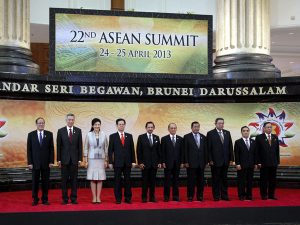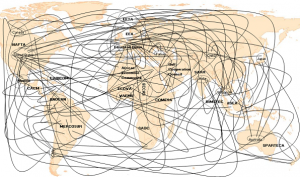Memo #223
By Matthew A. J. Levine and Junianto James Losari
matthew.a.j.levine [at] gmail.com / jlosari [at] gmail.com
 National ministers, Association of Southeast Asian Nations (ASEAN) officials, and managers of regional and foreign multinationals as well as representatives of small and medium enterprises in the region marked the entry into force of the ASEAN Comprehensive Investment Agreement (ACIA) with a day-long event in Kuala Lumpur this April.
National ministers, Association of Southeast Asian Nations (ASEAN) officials, and managers of regional and foreign multinationals as well as representatives of small and medium enterprises in the region marked the entry into force of the ASEAN Comprehensive Investment Agreement (ACIA) with a day-long event in Kuala Lumpur this April.
Although ASEAN is the most sophisticated intra-governmental co-operation mechanism in Asia, the lack of a joint-communiqué following its most recent leaders’ summit raised concerns about the organization’s continued relevance. ASEAN’s consensus-based approach clearly continues to yield returns in the economic domain, however, with ACIA paving the way toward a planned ASEAN Economic Community in 2015.
ACIA’s National Treatment and Most-Favoured Nation treatment clauses are clearly drafted and leave no wiggle room for discrimination against foreign investors. These commitments are backed up by recourse to binding international arbitration. ACIA also provides for progressive liberalization in several sectors, thus creating new opportunities for investors. In such a diverse region—ASEAN’s members include some of Asia’s poorest countries, prominent middle-income countries, and a wealthy city-state—reaching such agreement is a success for ASEAN. Indeed, ACIA may even be a useful case study for how negotiations over a proposed Trans-Pacific Partnership can address the wide range of socio-economic development amongst negotiating parties.
The proliferation of bilateral investment agreements—more than two thousand have been signed since 1959—mirrors the infamous “spaghetti-bowl effect” whereby each set of members in a trade grouping is connected by spaghetti-like strands of preferential agreements that create distinct rights and obligations. Through ACIA, ASEAN has moved to cover the noodles of intra-ASEAN bilateral investment agreements with a gratin-like cover of rules applying uniformly across the region.
ACIA should be earning ASEAN and its member countries plaudits. After all, by protecting intra-ASEAN investments and establishing rules-based procedures for resolving disputes, ACIA encourages economic integration while guarding against the tensions that can sometimes follow.
A final point of particular interest for North American readers is that ACIA’s substantive provisions as well as its regional rather than bilateral membership follow the NAFTA model. North American economic diplomacy continues to influence contemporary developments in the Asia-Pacific.

ASEAN leaders at their most recent summit in Brunei in April. From left: Philippine President Benigno Aquino, Singapore’s Prime Minister Lee Hsien Loong, Thailand’s Prime Minister Yingluck Shinawatra, Vietnam’s Prime Minister Nguyen Tan Dung, Brunei’s Sultan Hassanal Bolkiah, Myanmar’s
President Thein Sein, Cambodia’s Prime Minister Hun Sen, Indonesia’s President
Susilo Bambang Yudhoyono, Laos Prime Minister Thongsing Thammavong and
Malaysia’s Senate President Abu Zahar Ujang.
Source: http://globalnation.inquirer.net/73055/southeast-asian-leaders-urge-china-to-discuss-rows
About the Authors:
Matthew Levine is a Canadian lawyer whose practice focuses on international trade and investment law.
James Losari is an Indonesian lawyer and an LL.M. (Universidad de Barcelona) holder working with the Centre for International Law of the National University of Singapore.
Links:
- How ASEAN protects Singaporean Investments Abroad, Singapore Business Review, May 2012
- Thailand Must Prepare Soon for ASEAN Community, Asia News, Feb 2010
Related Memos:
- See our other memos on Southeast Asia

[…] http://www.asiapacificmemo.ca/gratin-on-the-noodle-bowl-new-asean-investment-agreement-promotes-regi… Share this:TwitterFacebookLike this:Like Loading… This entry was posted in Uncategorized. Bookmark the permalink. […]
[…] http://www.asiapacificmemo.ca/gratin-on-the-noodle-bowl-new-asean-investment-agreement-promotes-regi… Share this:TwitterFacebookGoogleLike this:Like Loading… […]